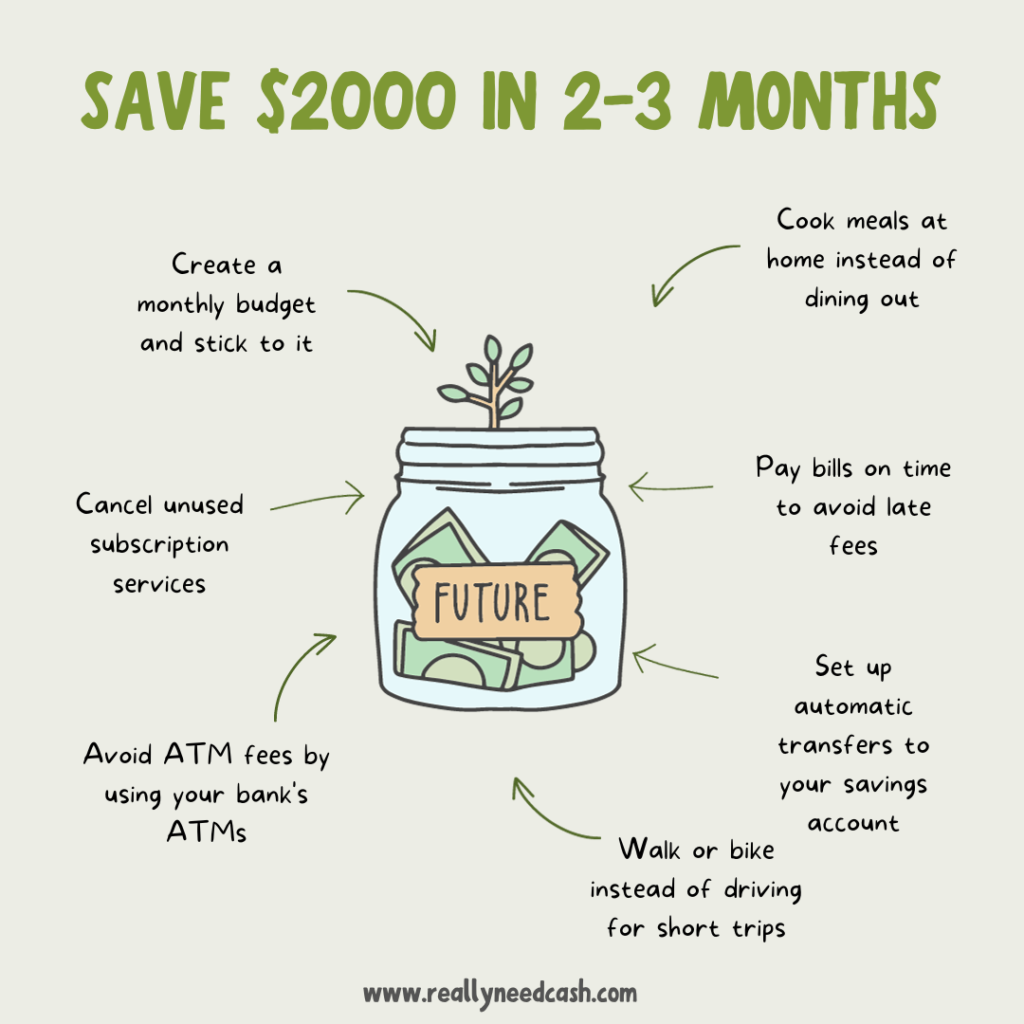To save $2000 in 2-3 months: Pay off your debt, cut down unnecessary expenses, Sell stuff, lower your gas usage, Get discounts on food and entertainment, and invest in a savings account to reach your goal faster. You will need approximately $667 each month to reach the mark of $2000 in 3 months.
If you are unemployed, underemployed, or having trouble managing your daily finances, saving aggressively may not be a good idea for you right now.
The strategies I am going to mention in this post are exclusively for people with a steady income–trying to save for a financial goal such as a vacation, a car down payment, or a wedding.
Expert Tip: try to sell stuff that you no longer need if you wish to save faster. This is an effortless way to make some extra bucks while you are following other more practical saving strategies. Online thrift stores, garage sells, and trading apps present an excellent way to sell miscellaneous items at good prices.
– Laurens Yarpei

51 Ways to Save $2000
- Be strategic with your Saving and Eating habits.
- Create a monthly budget and stick to it.
- Cook meals at home instead of dining out.
- Use coupons and cashback apps when shopping.
- Buy generic or store-brand products.
- Reduce your energy consumption by turning off lights and appliances when not in use.
- Cancel unused subscription services.
- Use public transportation or carpool to save on fuel costs.
- Buy in bulk for non-perishable items.
- Shop during sales and take advantage of discounts.
- Brew your own coffee instead of buying it daily.
- Cut down on impulse purchases.
- Bring your lunch to work or school.
- Repair and maintain items instead of replacing them.
- Buy second-hand or refurbished electronics and furniture.
- Negotiate your bills for cable, internet, and insurance.
- Unplug chargers and devices when not in use.
- Avoid ATM fees by using your bank’s ATMs.
- Set up automatic transfers to your savings account.
- Sell unused items on online marketplaces.
- Host potluck dinners instead of dining out with friends.
- Use public libraries for books and entertainment.
- Consider a staycation instead of an expensive vacation.
- Find free or low-cost local events for entertainment.
- Use energy-efficient appliances and lighting.
- Walk or bike instead of driving for short trips.
- Cut down on alcohol and restaurant outings.
- Make your cleaning products at home.
- Reduce water consumption by fixing leaks and taking shorter showers.
- Pay bills on time to avoid late fees.
- Plan your shopping trips and stick to a list.
- Purchase clothing during clearance and end-of-season sales.
- Review your insurance policies for potential savings.
- Buy and freeze sale-priced meats and produce.
- Buy a reusable water bottle instead of bottled water.
- Consider carpooling or ridesharing services.
- DIY home repairs and improvements when possible.
- Use a programmable thermostat to save on heating and cooling.
- Buy pre-owned vehicles to save on depreciation.
- Negotiate with creditors for lower interest rates.
- Make your own gifts for special occasions.
- Use free or low-cost exercise options like walking or home workouts.
- Shop at thrift stores and consignment shops for clothing.
- Refinance high-interest loans to lower your interest rates.
- Invest in a programmable coffee maker instead of costly coffee shops.
- Downsize to a smaller home or apartment if feasible.
- Compare prices and reviews before making major purchases.
- Avoid high-interest credit card debt by paying your balance in full.
- Opt for store loyalty programs and rewards.
- Avoid impulse online shopping by using website blockers.
- Review your expenses periodically to identify more ways to save.

Calculate how much money you need to earn and save each month to reach your goal and keep on it until you reach your goal.
Practical Tips to Save $2000 in 2-3 months
| Tips | Description |
|---|---|
| 1. Reduce discretionary expenses | Trim non-essential spending like dining out and subscription services. |
| 2. Monetize unused items | Convert unused possessions into cash by selling them online or in a garage sale. |
| 3. Lower your transportation costs | Find ways to reduce expenses related to your vehicle, such as carpooling or using public transportation. |
| 4. Optimize home utility bills | Take steps to lower your electricity, water, and heating/cooling costs by being more energy-efficient. |
| 5. Prioritize savings | Temporarily redirect your funds towards building savings and reducing debt. |
| 6. Make saving enjoyable | Turn saving into an engaging challenge to stay motivated and achieve your goals. |
| 7. Optimize essential expenses | Look for ways to cut costs on necessary expenditures like groceries and utilities. |
| 8. Explore additional income sources | Seek out additional sources of income through part-time work or freelancing. |
| 9. Adjust your tax withholding | Optimize your tax withholding to keep more of your earnings in each paycheck. |
10. Get a budget-friendly internet | Sign up for an internet connection that is affordable as well as super-fast and reliable. Pro tip: if you’re open to recommendations, check out Xfinity internet. |
In this step-by-step guide, I’ll show you how to save money and walk through a few methods to consider.
Method 1: Break down your Finances
So, what do I mean by “breaking down finances?” A simple assessment of your current financial situation! Before you plan to save, you need to have a clear view of how your bank account looks.
Do you have any outstanding debt? How many income sources do you have? Do you keep a record of your monthly expenses?
While these questions may sound very basic, your head will start spinning when you actually sit down to track your expenses and consider other financial factors. And I have seen many people overlook this step when they are trying to save for near-term goals.
So, here’s a reminder: having a clear record of expenses, income, and debt is crucial for a healthy financial life.
- Review income: if you earn from more than one source, it’s important to review your income before you plan to save. Calculate your salary, stipends, freelance work income, etc., and write it all down.
- Identify debt: car loans, mortgages, and outstanding debts can ruin all your financial planning. So, identifying all your debt is crucial.
- Track expenses: list down all your monthly expenses including utilities, rent, grocery, fuel, and other important spending.
Method 2: Tone down your monthly expenses
It’s important to cut back on something when you are trying to save money.
You don’t necessarily have to turn your life around and go live in a cave–just some minor adjustments like cutting on digital subscriptions, avoiding takeouts, and preferring public transport over cars will do.
And remember, you don’t have to make these changes for a lifetime. If you earn a reasonable amount every month, cutting on these expenses for just two or three months will really tone down your budget.
Method 3: Make your money work hard for you
Do you want your savings to make more savings for you? Consider signing up for a high-yield savings account. It’s an excellent way to secure your funds while also making free money.
Most traditional accounts that brick-and-mortar banks offer aren’t very competitive in terms of APY. You will hardly receive 0.01% to 0.4% APY which is no good when you are trying to make $2000 in three months.
What you need is a solid savings account that pays good interest and secures your funds for a near-term goal. I suggest my readers to go for high-yield savings accounts if they are trying to make money faster. Most of these accounts pay an interest rate of 4% or more.
And interestingly, you won’t be asked for an opening deposit or a monthly maintenance fee because these accounts are operated by online banks.
Method 4: Automation is the Key
Automating your finances can be a huge relief when you are trying to save big chunks in less time. If you have a checking account, set up automatic transfers to your savings account each week.
This advice is especially useful for people who are always forgetful or disorganized about their savings. If you find it hard to separate a set amount each week from your checking account to save for a big goal, automatic transfers will help you a lot.
We are talking about saving $2000 in 2-3 months. So, a deposit of approximately $167 each week is the way to go.
Even if you aren’t capable of saving $167 each week, setting an automatic transfer with less amount will still benefit you in the long run.
Method 5: Start a Side Hustle
One of the most obvious ways to save more is to earn more! It’s as simple as that.
If you are short on money and desperately trying to save $2000 for a big goal, consider starting a side hustle. It’s not that difficult to kickstart something in your free time given the opportunities available these days.
Here are some side hustles that you may want to consider:
- Working as a delivery agent
- Pet sitting or babysitting
- Working at a daycare
- Freelance writing or graphic designing
- Driving Uber
- Working as a part-time sales representative
How To Save Money (even when you don’t earn a lot)?
Saving money can be difficult. It requires a lot of discipline, effort, and financial planning to save even 500 dollars in these economic conditions. And we are talking about saving $2000 in 2-3 months.
Is this even possible for people who have a steady income but don’t make a lot?
Well, you don’t have to earn a lot to learn to save effectively. Setting clear financial goals and changing small habits can take you a long way.
Cutting out daily coffee runs, dining out, and subscription services is like a fast track to saving $2000. Small changes add up to big savings!
How to Save $2,000 in 3 months Using the 50/30/20 Budgeting Method
To save $2,000 in 3 months using the 50/30/20 budgeting method, you can follow these steps:
- Calculate Your Total Monthly Income:
- If you make $2,500 a month after tax, your monthly income is $2,500.
- Determine Your Savings Target:
- Your savings target is $2,000 over 3 months, which means you need to save approximately $667 per month ($2,000 ÷ 3).
- Allocate 20% of Your Income to Savings:
- In your case, 20% of your $2,500 monthly income is $500. This is the amount you need to save each month to reach your goal of $2,000 in 3 months.
To break it down further:
- Per day: $500 ÷ 30 days (average month) ≈ $16.67 per day.
- Per week: $500 ÷ 4 weeks ≈ $125 per week.
So, to save $2,000 in 3 months, you’ll need to earn approximately $16.67 per day, $125 per week, and allocate 20% of your $2,500 monthly income toward savings as per the 50/30/20 budgeting method.
This approach will help you reach your savings goal and, in the process, work toward getting out of debt more quickly.






